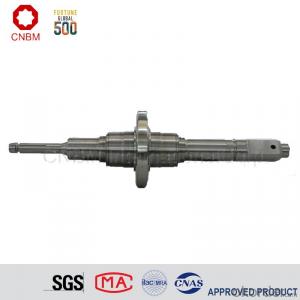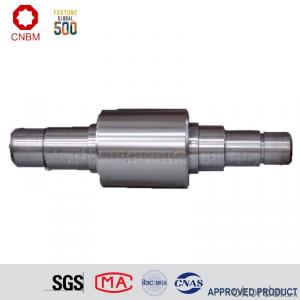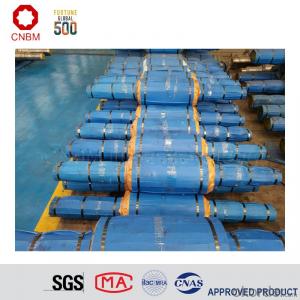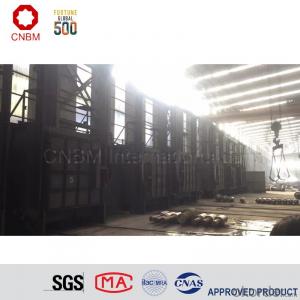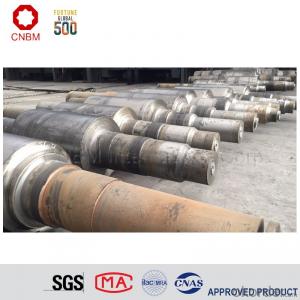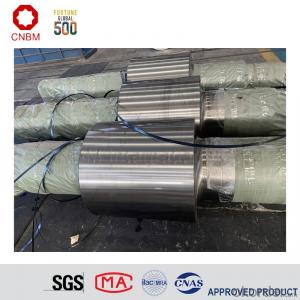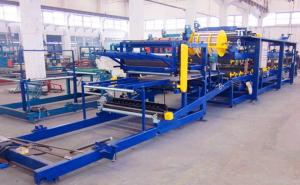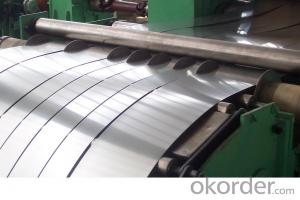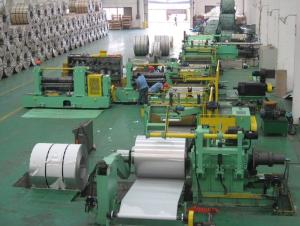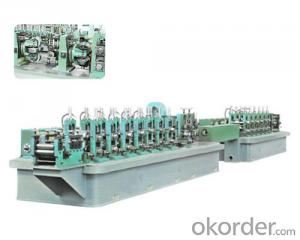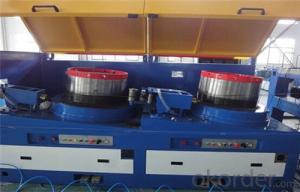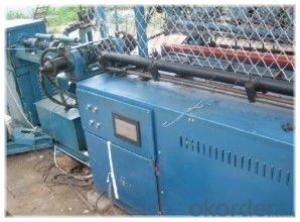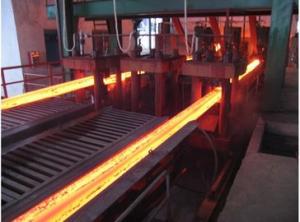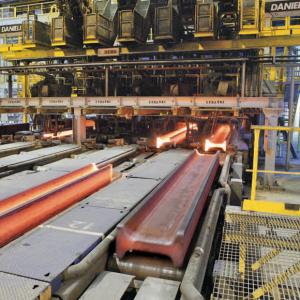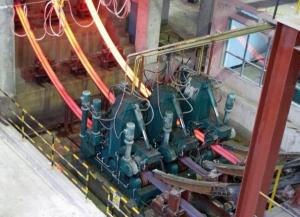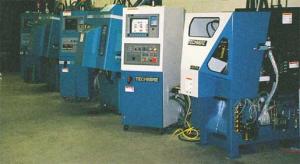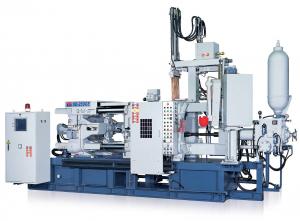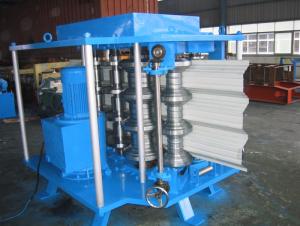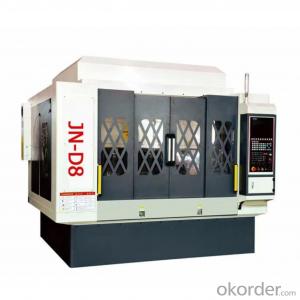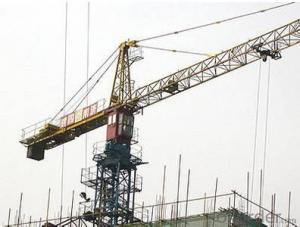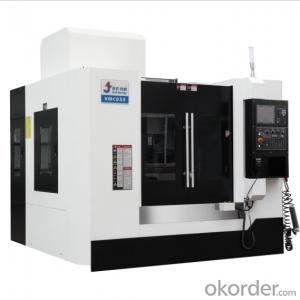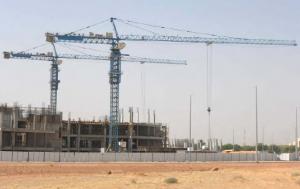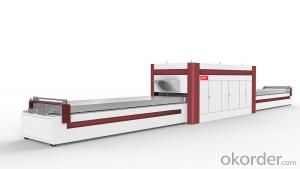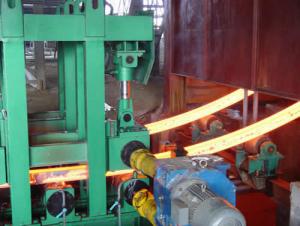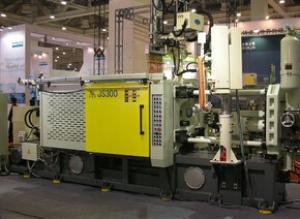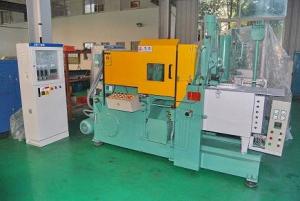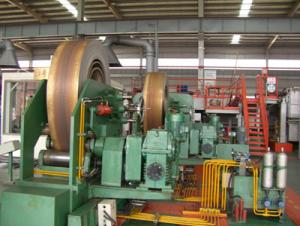Graphitic Steel Roll With High Wear Resistance and High Performance
- Loading Port:
- Tianjin
- Payment Terms:
- TT OR LC
- Min Order Qty:
- 2 m.t.
- Supply Capability:
- 41000 m.t./month
- Option:
- 650X1780X5540; 650X1780X5540; 680X2080X5920
OKorder Service Pledge
OKorder Financial Service
You Might Also Like
Item specifice
Company Profile
CNBM International Corporation (CNBM International) is the most important trading platform of CNBM Group Corporation, a state-owned company under the direct supervision of State-owned Assets Supervision and Administration Commission of the State Council.
CNBM Group is integrated with four business segments: Manufacture, R&D,Sets of equipment and Logistics trading.Mill rolls are our main products.
CNBM International is highly recognized by its business partners and clients all over the world and has established good business relationship with the customers in over 120 countries and regions all over the world.

The product introduction of mill roll
Equipped with advanced technological facilities on melting, casting, forging, heat treating and mechanical machining, our factory has formed 9 professional complete roll manufacturing lines of cast steel, cast iron and forged steel rolls such as strip mill rolls, heavy section mill rolls, wire & bar rolls, special shaped rolls and small-sized cold rolls and specialized production lines of bloom and slab CCM, coke oven equipments and wind power products. Annual production capacity of mill rolls is 500,000 tons, metallurgical equipment is 80,000 tons.

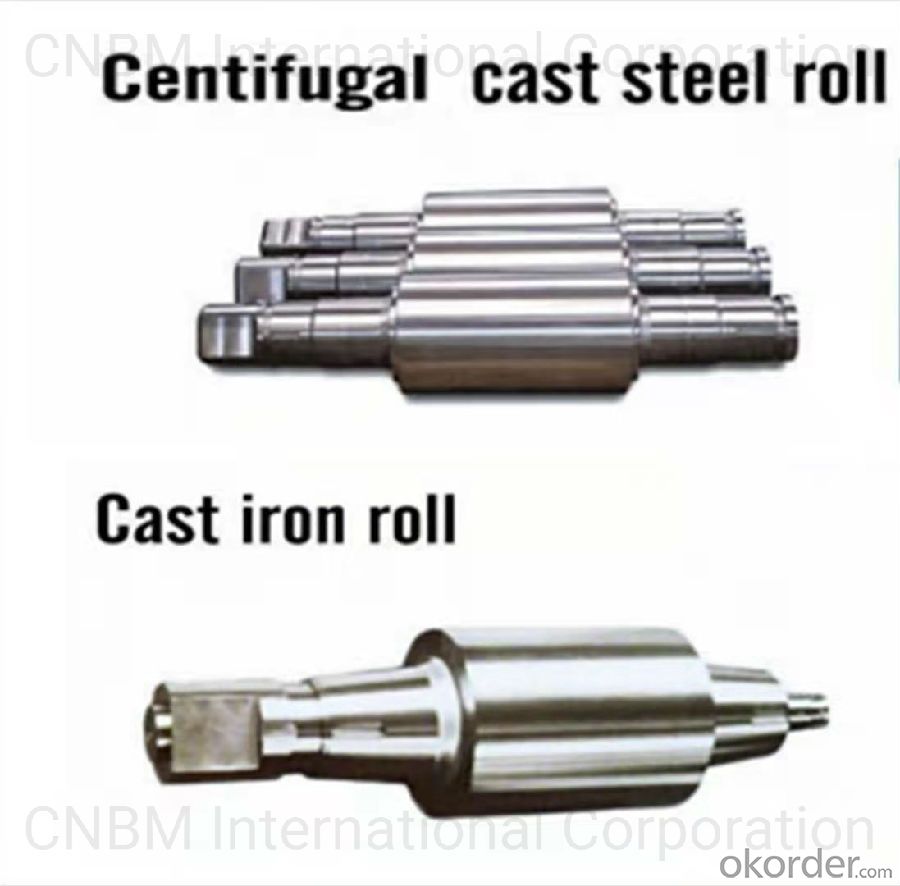
Workshop
Workshop is the core of our company and undertakes all of scientific research work. The company specially produces and supplies all kinds of roll used for hot strip mill, cold strip mill, plate & heavy plate mill, large-sized section mill, universal mill etc.

Products & Specification
| Mill | Application | Material | Product Specification | ||
| Hot Strip Mill | Large-sized vertical roll | Special alloy cast roll, Adamite | All Sizes | ||
| Small-sized vertical roll | Adamite, HiCr iron | ||||
| Roughing work roll | Special alloy cast steel, Adamite, HiCr steel, Semi-HSS, HiCr iron | ||||
| Finish rolling | Early stand work roll | HiCr iron, HSS | |||
| Later stand work roll | ICDP, HSS | ||||
| Finishing back-up roll | Duplex cast steel | D≤¢2000,W≤80t | |||
| Alloy forged steel | D≤¢2000,W≤75t | ||||
| Temper rolling | Work roll | HiCr iron | All Sizes | ||
| Alloy forged steel | |||||
| Back-up roll | ICDP | ||||
| Duplex cast steel | D≤¢2000, W≤80t | ||||
| Alloy forged steel | D≤¢2000, W≤75t | ||||
| Mill | Application | Material | Product specification |
Cold strip mill & Single stand cold mill | Work roll | Alloy forged steel | All Sizes |
| Intermediate roll | Alloy forged steel | ||
| Temper roll | Alloy forged steel | ||
| Back-up roll | Duplex cast steel | D≤¢2000,W≤80t | |
| Alloy forged steel | D≤¢2000,W≤75t | ||
Largesized universal structural mill | Break-down roll | Special alloy cast steel, alloy nodular iron | All Sizes |
| Horizontal collar | High carbon adamite (duplex) | ||
| Vertical collar | High carbon adamite, HiCr iron | ||
| Edger roll Edger roll | High carbon adamite | ||
| Shaft | Alloy forged steel |
| Mill | Application | Marterial | Product Specification | |
| CSP | Vertical Roll | Adamite, Special alloy cast steel, HiCr iron | All Sizes | |
| Roughing work roll | Semi-HSS, HiCr Steel | |||
| Finish rolling | Early stand | HiCr iron, HSS | ||
| Later stand | ICDP, HSS | |||
| Roughing & Finishing back-up roll | Duplex cast steel | D≤¢2000,W≤80t | ||
| Alloy forged steel | D≤¢2000,W≤75t | |||
| Steckel Mill | Vertical roll | Adamite, Special alloy cast steel | All Sizes | |
| Roughing work roll | ICDP, HiCr iron | |||
| Finishing work roll | HiCr iron, ICDP | |||
| Back-up roll | Duplex cast steel | D≤¢2000,W≤80t | ||
| Alloy forged steel | D≤¢2000,W≤75t | |||
| Plate & Heavy plate mill | Rough rolling | 2-hi work roll | Special alloy cast steel, Tool steel | All Sizes |
| 4-hi work roll | HiCr iron, ICDP | |||
| Finishing work roll | HiCr iron, ICDP | |||
| Single stand work roll | HiCr iron, ICDP | |||
| Back-up roll | Duplex cast steel | D≤¢2000,W≤80t | ||
| Alloy forged steel | D≤¢2000,W≤75t | |||
Quality Control
The company has the most advanced experimental and testing equipments in global mill roll industry, including direct-reading spectrometer, spectrum analyzer , X-ray fluorescence analyzer, scanning electronic microscope, energy disperse spectroscopy, X-ray diffractometer, image analyzer, high/low temperature metallographic microscope, X-ray stress meter, brittleness temperature tester, thermal analogue machine, dilatometer, macro and micro hardness tester, OMNISCAM-1X automatic flaw detection, USN60 ultrasonic flaw detector, magnetic powder and non-destructive flaw detection etc,. The advanced inspection equipments and experimental methods provide guarantee for quality control and experiment on material, usability test and performance.
The factories of CNBM invested 2.3 billion RMB for large-scale
CNBM international Corporation has completed equipment and technology upgrade transformation, which was concentrated on three projects, production line of centrifugal casting rolls for hot strip and plate mill, forged roll for cold/hot strip mill, national class technology center and roll material lab. Through upgrade transformation, the following targets have been achideved:
(1)It becomes the world's biggest specialized mill roll maker with the largest production scale, the most complete specifications of products and the most extensive coverage of various rolls used on rolling mill.
(2) The technology of equipments has reached international leading level.
(3) "Mechanization, automation, intellectualization, digitization" of equipments obviously improve the quality control ability.
(4) New types of research instruments improve the R&D capacity of products.
Customers Visit
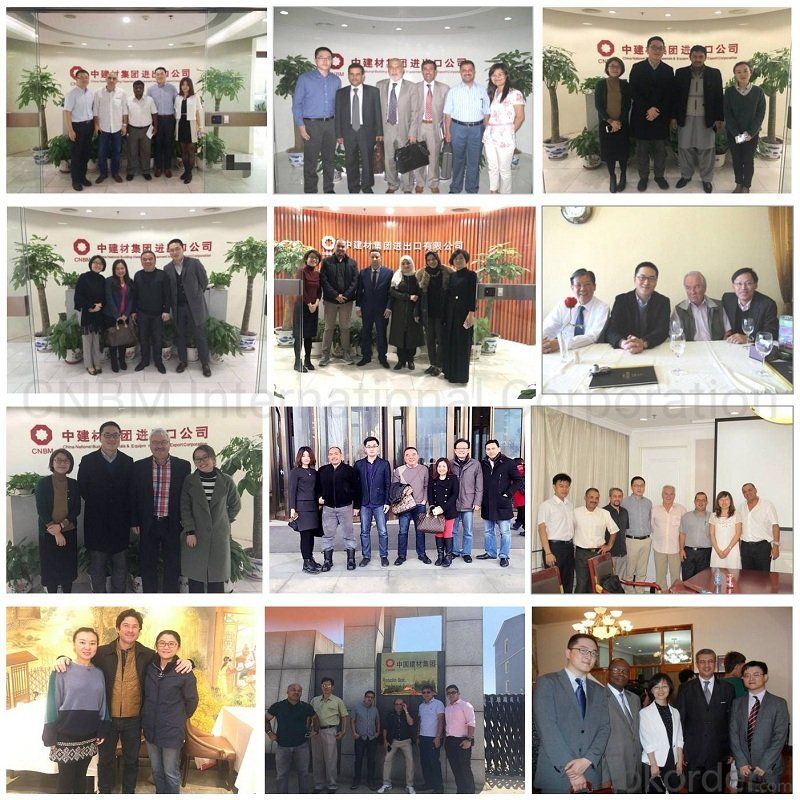
FAQ
Q:Are you a trading company or manufacturer?
A:CNBM is a large-scale central governmental industrial group with its own manufacturing sector, research and development sector, trading sector and logistics sector.
Q:I have some special requirement about specifications.
A:We have a well-rounded product range, which endows us with the capability of applying many special specifications. Please feel free to contact us with yours.
Q:Do you accept OEM service?
A:Yes, we do.
Q:What is your delivery time?
A:It depends on the size/complexity of your order and our own production schedule. Usually we provide a faster delivery than the industry's average.
Q:What is the payment term?
A:Our payment terms are negotiable.
Q:Can I have my own logo on the product?
A:Sure, we can apply your own logo on the products according to your requirement.
- Q:How does metal casting machinery handle the heat treatment processes of castings?
- Metal casting machinery typically handles the heat treatment processes of castings by subjecting them to controlled heating and cooling cycles. This helps to enhance the mechanical properties and overall performance of the castings. Heat treatment can be conducted in various ways such as annealing, quenching, tempering, or stress relieving, depending on the desired outcome. The machinery provides precise temperature control and time management to ensure the castings are exposed to the appropriate heat treatment process, resulting in improved strength, hardness, and durability.
- Q:Can metal casting machinery be used for the production of jewelry?
- Jewelry production can make use of metal casting machinery. The process involves pouring molten metal into a mold, allowing it to solidify, and then removing the mold to reveal the desired shape. This technique is commonly employed in the manufacturing of different types of jewelry, including rings, necklaces, bracelets, and earrings. To create intricate and detailed jewelry pieces, jewelers can utilize metal casting machinery, such as centrifugal casting machines, vacuum casting machines, and investment casting machines. These machines enable accurate and efficient reproduction of complex designs. The choice of metal for jewelry casting can vary depending on the desired aesthetic and durability. Precious metals like gold, silver, and platinum are commonly used, but unique and affordable jewelry pieces can be created by casting other metals like brass, bronze, and stainless steel. The advantages of metal casting machinery in jewelry production are numerous. It allows for mass production, ensuring consistent quality and reducing manufacturing time. It also expands the creative possibilities for jewelers to experiment with different designs, textures, and patterns. However, it should be noted that while metal casting machinery can be used for jewelry production, additional processes such as polishing, plating, and stone setting may be necessary to achieve the final desired result. These additional steps add value and enhance the overall appearance of the jewelry piece. In conclusion, metal casting machinery is a valuable tool for jewelry production. It facilitates the creation of intricate designs, mass production, and experimentation with various metals. With the right machinery and expertise, the possibilities for creating beautiful and unique jewelry are endless.
- Q:What are the different types of coatings used with metal casting machinery?
- Metal casting machinery commonly utilizes various types of coatings. These coatings are applied to the die or mold surfaces to enhance casting quality and prolong mold lifespan. Some examples of coatings used in metal casting machinery are: 1. Refractory coatings: Made from materials like zircon, graphite, or alumina, these coatings create a protective layer on the mold surface. They prevent the molten metal from reacting with the mold material and reduce defects such as metal penetration, erosion, or sand burn-in. 2. Ceramic coatings: Usually composed of silica, alumina, or zirconia, ceramic coatings provide excellent heat resistance, thermal shock resistance, and high hardness. They improve casting surface finish, dimensional accuracy, and decrease defects like porosity or surface roughness. 3. Anti-stick coatings: These coatings, often made from boron nitride or graphite, prevent molten metal from sticking to the mold surface. They ensure easy release of the casting, minimizing the risk of damage or defects. 4. Release coatings: Used to facilitate easy casting removal, these coatings create a lubricating layer between the mold and casting, minimizing friction and preventing sticking. Silicone-based compounds or water-based emulsions are commonly used for release coatings. 5. Protective coatings: Applied to metal components of casting machinery, these coatings safeguard against corrosion, wear, or abrasion. They can be made from metallic alloys, polymer-based compounds, or ceramic materials. Protective coatings extend machinery lifespan and enhance performance. The choice of coating depends on factors such as the metal type, desired surface finish, casting complexity, and specific process requirements. Each coating type possesses unique properties and advantages. Selecting the appropriate coating is crucial for achieving high-quality castings and optimizing efficiency in metal casting machinery.
- Q:How is foam pattern made and assembled for lost foam casting in metal casting machinery?
- The foam pattern used in lost foam casting is typically made by injecting expanded polystyrene (EPS) beads into a mold that is shaped like the desired final metal part. The EPS beads are heated and expand to fill the entire mold cavity, creating a three-dimensional foam pattern. Once the foam pattern is formed, it is removed from the mold and assembled with other foam patterns to create a cluster. The cluster is then coated with a refractory material to create a shell around the foam patterns. During the metal casting process, the molten metal is poured into the shell, vaporizing the foam patterns and filling the void with liquid metal, resulting in the desired metal part.
- Q:What are the considerations for core design in metal casting machinery?
- When it comes to the core design in metal casting machinery, there are several crucial factors that need to be taken into consideration. These factors include: 1. Core material: The core material should possess excellent dimensional stability, high heat resistance, and minimal gas evolution during casting. Additionally, it should be easily collapsible or removable after the casting process. 2. Core size and shape: The size and shape of the core should be carefully designed to create the desired internal features of the cast part. It should be able to be inserted into the mold cavity without causing any damage or distortion. 3. Core placement and orientation: The positioning and orientation of the core within the mold cavity should be meticulously determined to ensure the proper filling of the molten metal and to prevent any potential defects like porosity or incomplete filling. 4. Core supports: Sufficient support structures should be designed to securely hold the core in place during the casting process. These supports need to be strong enough to withstand the weight of the molten metal and prevent any displacement or shifting of the core. 5. Core venting: Proper venting is crucial to allow gases to escape from the core during casting. Insufficient venting can result in defects such as gas porosity or blowholes in the final casting. 6. Core removal: After the casting process, it is necessary to remove the core from the solidified metal. The design should take into account the ease of removal, ensuring that no damage is caused to the casting. 7. Core tooling: The design of the core tooling, including the core box and any necessary inserts or cores, should be optimized for precision and repeatability. It should facilitate easy assembly and disassembly, as well as simple maintenance and repair. 8. Core quality control: It is essential to have quality control measures in place to ensure the integrity and accuracy of the cores. This may involve regular inspections, testing, and monitoring to identify any defects or deviations from the desired specifications. In summary, the considerations for core design in metal casting machinery revolve around achieving the desired internal features of the cast part, ensuring proper casting fill, minimizing defects, facilitating core removal, and maintaining quality control throughout the process.
- Q:What are the different types of casting defects that can occur in investment casting?
- Some common types of casting defects that can occur in investment casting include shrinkage porosity, gas porosity, surface roughness, mold erosion, hot tears, and misruns.
- Q:What are the common molding materials used in die casting with metal casting machinery?
- The common molding materials used in die casting with metal casting machinery are primarily metals and alloys that have a low melting point and good fluidity. The most commonly used materials include aluminum, zinc, magnesium, and copper-based alloys. Aluminum is widely used in die casting due to its excellent strength-to-weight ratio, corrosion resistance, and high thermal conductivity. It is also easily recyclable, making it an environmentally friendly choice. Zinc is another popular material for die casting, known for its low melting point, good dimensional stability, and ability to produce intricate shapes with thin walls. Magnesium is often used in applications where weight reduction is a priority, as it is the lightest structural metal. It offers excellent strength and stiffness, along with good thermal and electrical conductivity. Copper-based alloys, such as brass and bronze, are commonly used for die casting applications that require high strength, corrosion resistance, and good electrical conductivity. In addition to these primary materials, various secondary materials and additives are often incorporated into the molding process to enhance the properties of the final castings. These may include grain refiners, modifiers, lubricants, and release agents, among others. Overall, the choice of molding material depends on the specific application requirements, desired properties of the castings, and cost considerations.
- Q:How is the dimensional accuracy of castings achieved with metal casting machinery?
- The dimensional accuracy of castings is achieved with metal casting machinery through several key processes and techniques. Firstly, the design and preparation phase is crucial in ensuring dimensional accuracy. The casting patterns are created with precise measurements and specifications, which serve as the templates for the final product. Careful attention is given to factors such as shrinkage allowances, draft angles, and tolerances to account for any dimensional changes that may occur during the casting process. Once the patterns are ready, they are used to create molds. Metal casting machinery facilitates the creation of molds with high precision and accuracy. Advanced technologies such as computer-aided design and computer-aided manufacturing (CAD/CAM) are often employed to ensure the molds are made to the exact specifications of the patterns. This helps in maintaining dimensional accuracy and consistency throughout the casting process. During the actual casting process, precise control of various parameters is essential. The metal casting machinery enables accurate control over factors such as melting temperature, pouring temperature, and cooling rates. This control ensures that the molten metal flows smoothly into the mold, filling all the intricate details and contours. Maintaining proper temperature control also minimizes the risk of dimensional variations caused by thermal expansion or contraction. Furthermore, metal casting machinery often incorporates advanced techniques such as vacuum casting, pressure casting, or centrifugal casting. These techniques help in achieving higher dimensional accuracy by reducing the occurrence of defects like porosity, shrinkage, or uneven cooling. Vacuum casting, for instance, eliminates air bubbles and ensures a complete and uniform filling of the mold, resulting in precise dimensions. After the casting process, post-processing steps such as heat treatment, machining, and finishing are carried out to achieve the desired dimensional accuracy. Machining processes like milling, turning, or grinding are used to remove excess material and bring the castings to the required dimensions. Precision measuring instruments and quality control techniques are employed to verify the dimensional accuracy of the final castings. In summary, the dimensional accuracy of castings is achieved with metal casting machinery through careful design and preparation, precise mold creation, accurate control of casting parameters, advanced techniques, and post-processing steps. These processes work in conjunction to ensure that the final castings meet the specified dimensional requirements.
- Q:What are the different types of maintenance practices used in metal casting machinery?
- There are several different types of maintenance practices that are commonly used in metal casting machinery to ensure its optimal performance and longevity. These practices can vary depending on the specific needs and requirements of the machinery, but some of the most common types of maintenance include preventive maintenance, predictive maintenance, corrective maintenance, and breakdown maintenance. Preventive maintenance involves regularly scheduled inspections, cleaning, lubrication, and minor adjustments to prevent potential issues and maintain the machine's efficiency. This type of maintenance is typically performed based on a predetermined schedule or number of operating hours and aims to identify and fix potential problems before they become major issues. Predictive maintenance, on the other hand, utilizes advanced technologies such as vibration analysis, thermal imaging, and oil analysis to monitor the condition of the machinery and predict when maintenance or repairs may be required. By continuously monitoring key indicators, operators can identify potential faults or failures and take proactive measures to prevent costly breakdowns or production disruptions. Corrective maintenance is performed when a fault or failure has already occurred and aims to restore the machinery to its normal operating condition. This type of maintenance often involves replacing faulty components, repairing damaged parts, or making adjustments to rectify the issue. Corrective maintenance is typically carried out as soon as possible to minimize downtime and reduce the impact on production. Lastly, breakdown maintenance is performed when a machine has completely stopped functioning due to a breakdown or failure. This type of maintenance is typically reactive and is carried out as an emergency measure to quickly restore the machinery to a working condition. Breakdown maintenance is generally considered the least desirable type of maintenance as it often leads to significant downtime and can be costly to repair. Overall, a combination of these maintenance practices is usually employed in metal casting machinery to ensure its optimal performance, maximize its lifespan, and minimize the risk of unexpected breakdowns or failures. By implementing a comprehensive maintenance strategy, manufacturers can significantly improve the efficiency, reliability, and profitability of their metal casting operations.
- Q:How is the casting assembled and joined with other components in metal casting machinery?
- In metal casting machinery, the casting is assembled and joined with other components through various methods. One common method is by fastening or bolting the casting to other parts using screws, nuts, or bolts. Welding is another popular technique, where the casting is joined to other components by melting and fusing the metal together. Adhesive bonding can also be used, where a strong adhesive is applied between the casting and other parts to create a secure bond. Additionally, mechanical methods such as press-fitting or interference fitting can be employed to assemble and join the casting with other components, ensuring a tight and stable connection.
1. Manufacturer Overview |
|
|---|---|
| Location | |
| Year Established | |
| Annual Output Value | |
| Main Markets | |
| Company Certifications | |
2. Manufacturer Certificates |
|
|---|---|
| a) Certification Name | |
| Range | |
| Reference | |
| Validity Period | |
3. Manufacturer Capability |
|
|---|---|
| a)Trade Capacity | |
| Nearest Port | |
| Export Percentage | |
| No.of Employees in Trade Department | |
| Language Spoken: | |
| b)Factory Information | |
| Factory Size: | |
| No. of Production Lines | |
| Contract Manufacturing | |
| Product Price Range | |
Send your message to us
Graphitic Steel Roll With High Wear Resistance and High Performance
- Loading Port:
- Tianjin
- Payment Terms:
- TT OR LC
- Min Order Qty:
- 2 m.t.
- Supply Capability:
- 41000 m.t./month
- Option:
- 650X1780X5540; 650X1780X5540; 680X2080X5920
OKorder Service Pledge
OKorder Financial Service
Similar products
New products
Hot products
